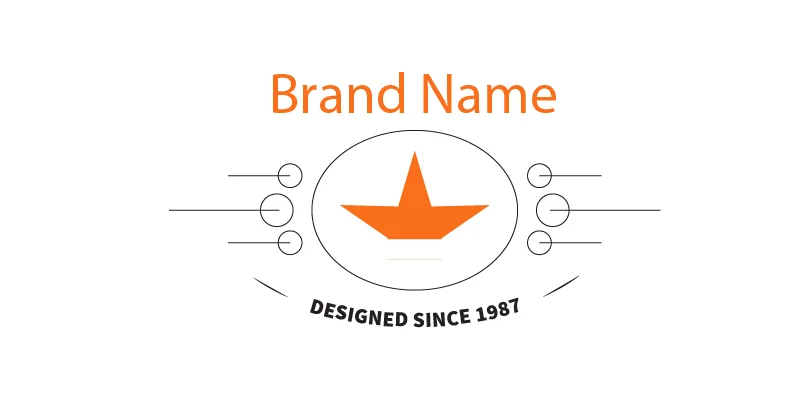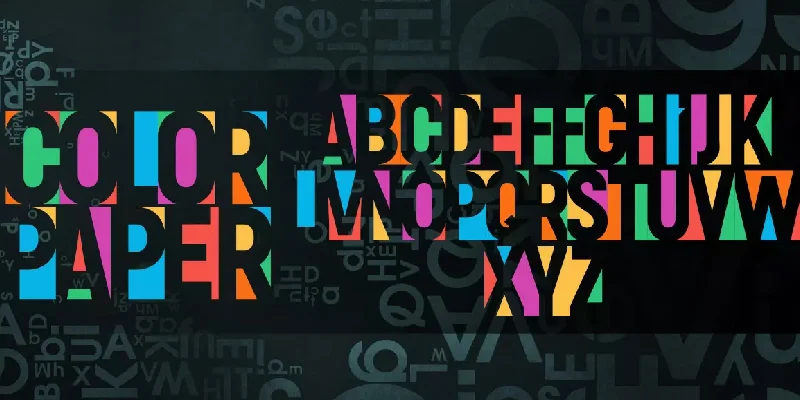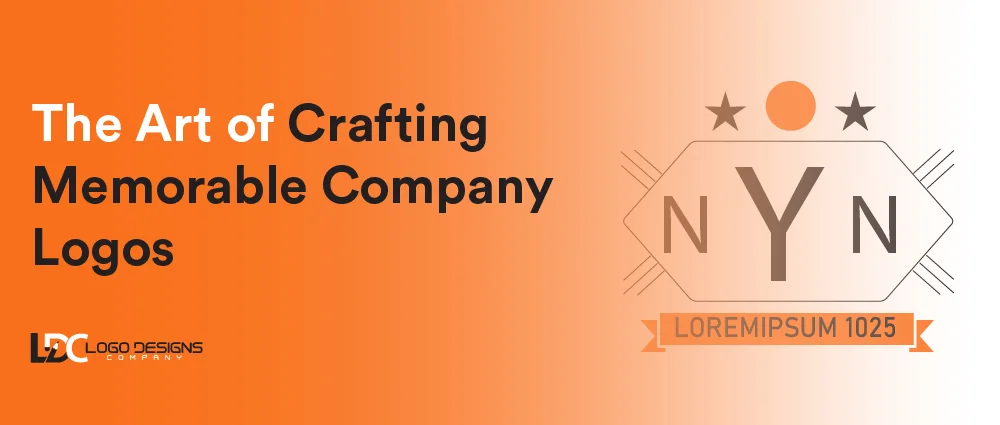In the contemporary and competitive business landscape, a company logo serves as its visual identity – a beacon that guides customers towards recognising and engaging with the brand. The significance of a well-designed logo cannot be understated. As we delve into the world of logo design, this weblog will focus on the fascinating realm of logo design in the UK, exploring how the fusion of art and branding principles results in impactful and enduring company logos.
The Evolution of Company Logos


Company logos have come a long way since their inception. From intricate monograms of medieval times to the sleek, minimalist designs of today, logos have always been a reflection of a company’s essence. According to a resource 78% of consumers believe that logos are works of art. In recent years, there has been a resurgence of interest in art-inspired logos, with businesses seeking to convey a deeper message through their visual representation.
Art and Logos: A Harmonious Connection


Art and logos share a unique connection, both seeking to communicate complex ideas through visual elements. The use of artistic concepts in logo design brings depth and symbolism to the brand’s identity. Artistic techniques such as colour theory, composition, and typography play a pivotal role in creating a visually appealing and emotionally resonant logo.
The Psychology of Colours in Logo Design


Colours have a profound impact on human emotions and perceptions. In logo design, the choice of colours is a strategic decision that communicates the brand’s values and personality. For instance, vibrant hues may convey energy and innovation, while muted tones may evoke sophistication and timelessness. A logo designed for an art-centric company might employ a palette that invokes creativity and imagination, fostering a strong connection with the audience.
Typography as an Artistic Expression


Typography is another art form that often finds its way into logo design. The typeface chosen for a logo can drastically alter its visual impact. Bold and modern fonts exude confidence and innovation, while elegant scripts can add a touch of sophistication. A logo representing an art-focused company might incorporate fluid, hand-drawn lettering to signify the organic and expressive nature of artistic creation.
Balancing Simplicity and Intricacy
The principle of simplicity is a cornerstone of effective logo design in the UK. A well-designed logo should be easily recognisable and versatile across different platforms. However, incorporating intricate artistic elements can elevate the logo’s appeal and make it memorable. Achieving this balance is a delicate art, where every curve and line contributes to the overall impact of the design.
The Iterative Design Process
Creating an impactful logo involves an iterative process of brainstorming, sketching, refining, and iterating. Designers experiment with various artistic elements to find the perfect balance that encapsulates the brand’s identity and resonates with the target audience. Feedback from stakeholders and target customers is invaluable in shaping the final design.
The Timeless Allure of Art Logos
In an era of rapid technological advancements, the allure of art logos remains timeless. They possess a unique ability to capture the essence of human emotion, creativity, and expression. As businesses strive to establish meaningful connections with their audiences, the fusion of art and logos provides a potent avenue for storytelling and brand differentiation.
Benefits of Art-Inspired Company Logos
In the world of logo design, where first impressions matter significantly, art-inspired logos bring a plethora of benefits to the table. These company logos go beyond mere visuals; they encapsulate a brand’s essence, values, and aspirations, leaving a lasting impact on the audience. In this segment, we’ll delve into the specific advantages of incorporating artistic elements such as colour, typography, and intricate design into logos.
The Psychology of Colours
When designing a logo, the careful selection of colours can evoke powerful emotions and shape perceptions. The benefits of harnessing the psychology of colours include:
-
Emotional Connection
Art-inspired logos often utilise a vibrant and diverse colour palette that sparks an emotional connection. For instance, warm tones like red and orange can convey passion and energy, while cool blues evoke a sense of calm and trust. These emotional triggers help the audience connect on a deeper level with the brand, fostering loyalty and brand recall.
-
Visual Differentiation
In a crowded marketplace, standing out is crucial. Artistic use of colours in logos can differentiate a brand from its competitors. Unconventional colour combinations or unique gradients can help the logo catch the eye and remain memorable, setting the brand apart.
-
Cultural and Symbolic Significance
Colours often hold cultural or symbolic meanings. Incorporating these meanings into a logo can resonate strongly with specific target audiences. For instance, a company celebrating cultural diversity might use a spectrum of colours to symbolise inclusivity and unity.
Typography as an Artistic Expression
Typography, the art of arranging type, plays a pivotal role in logo design. By integrating typography as an artistic expression, logos reap several benefits:
-
Brand Personality
Artful typography can visually convey a brand’s personality. Whether it’s bold and modern fonts for an innovative technology company or elegant scripts for a high-end fashion brand, typography helps reinforce the desired brand image.
-
Readability and Impact
The right typography enhances readability, ensuring that the brand name is easily identifiable and legible across various platforms and sizes. This readability contributes to a logo’s impact and recognisability.
-
Creative Storytelling
Artistic typography can tell a story in itself. The way letters are formed, spaced, or connected can communicate a sense of movement, sophistication, or playfulness, providing an additional layer of depth to the logo’s narrative.
Balancing Simplicity and Intricacy
Achieving the delicate equilibrium between simplicity and intricacy in CA logo design offers a host of benefits:
-
Memorability
An art-inspired logo, with its intricate details, is often more memorable than a plain, simple design. The audience is more likely to remember a logo that intrigues and engages their visual senses.
-
Versatility
While intricate designs can be attention-grabbing, they must also be adaptable. Striking the right balance ensures that the logo remains versatile, easy to reproduce across various mediums, from business cards to billboards.
-
Brand Story
The details within an intricate logo can narrate elements of the brand story or convey hidden meanings that intrigue and resonate with observant viewers. This creates a sense of discovery and encourages deeper engagement.
Exploring Diverse Art Logo Designs
In the world of logo design, artistry isn’t limited to just a single approach. Instead, it unfolds into a symphony of creativity, where various design styles harmonize to create unique and compelling art logos. As we journey further into the world of logo design, let’s delve into different types of art-inspired logo designs that capture the essence of brands in distinct and captivating ways.
-
Minimalist Marvels
Less is often more in the realm of minimalist art logos. These designs distill the brand’s identity into essential elements, creating an understated yet powerful visual impact. Minimalist art logos are marked by clean lines, simple shapes, and judicious use of negative space. This style appeals to brands aiming for a modern, sophisticated, and timeless image. A minimalistic art logo for a contemporary art gallery might feature a single, bold brushstroke that encapsulates the essence of artistic expression.
-
Abstract Abundance
Abstract art logos are a playground for creativity, embracing non-representational forms and patterns. These logos invite viewers to interpret and engage with the design on a personal level. Brands seeking to convey innovation and a forward-thinking mindset often gravitate towards abstract art logos. Imagine a technology company’s logo using abstract shapes to symbolize connectivity and advancement, sparking curiosity and conversation.
-
Vintage Vibes
Vintage or retro-inspired art logos evoke nostalgia and classic charm. This style often incorporates elements reminiscent of a bygone era, such as ornate typography, distressed textures, and muted colour palettes. Brands looking to establish a sense of tradition and authenticity can use vintage art logos to evoke a warm and familiar sentiment.
-
Illustrative Wonders
Illustrative logos are a feast for the eyes, combining intricate visuals with storytelling prowess. These logos often feature detailed illustrations that narrate a brand’s narrative or values. For an art supply company, an illustrative logo could depict a palette of vivid colours blending together to form a work of art, symbolizing the company’s commitment to creative exploration.
-
Playful Personalities
Playful art logos infuse a sense of whimsy and lightheartedness into branding. These logos use vibrant colours, quirky characters, and animated elements to create an approachable and friendly image. They’re ideal for brands targeting younger audiences or those aiming to inject a sense of fun into their image. An art-themed children’s educational platform might employ a playful art logo featuring colourful paint splatters forming the shape of a smiling face.
-
Typography Tales
Typography takes center stage in logo designs that prioritize the art of lettering. Brands can use custom typefaces, calligraphy, or hand-lettering to create a logo that’s not just a name but an artistic expression. This style is particularly effective for brands that want to highlight the craftsmanship behind their products or services, such as artisanal crafts or bespoke design studios.
-
Geometric Delights
Geometric art logos leverage shapes and patterns to convey precision, balance, and order. These logos often incorporate circles, squares, triangles, or intricate tessellations to create a visually captivating design. Geometric art logos can evoke a sense of professionalism and innovation, making them suitable for technology-driven companies or brands focused on intricate craftsmanship.
Diverse art logo designs, become evident that the artistry in in the UK knows no bounds. From minimalist marvels to playful personalities, each design style weaves a unique tapestry of creativity that resonates with a brand’s identity, values, and aspirations. By embracing different types of art-inspired logos, companies can craft a visual identity that not only captures attention but also leaves an indelible mark in the hearts and minds of their audience.
Conclusion
The art of logo design in the UK is a captivating journey that merges artistic expression with branding principles. By harnessing the power of colour psychology, typography, and intricate design elements, companies can craft logos that leave an indelible mark on their audiences. As the business world continues to evolve, the marriage of art and logos will undoubtedly continue to shape the visual landscape of brands, making a lasting impression that goes beyond mere recognition. Furthermore, if you are looking for business logo design, then get in touch with Logo Designs Company.
Also Read: Logo Design and Stationery Designs are actually your Brand Identity


